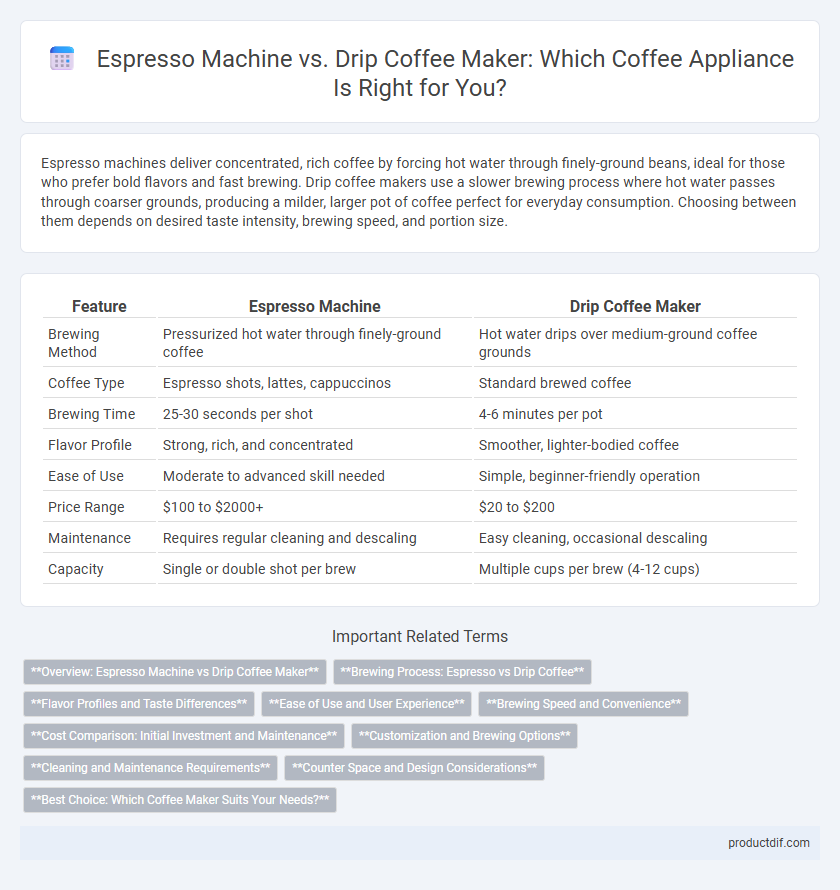Espresso machines deliver concentrated, rich coffee by forcing hot water through finely-ground beans, ideal for those who prefer bold flavors and fast brewing. Drip coffee makers use a slower brewing process where hot water passes through coarser grounds, producing a milder, larger pot of coffee perfect for everyday consumption. Choosing between them depends on desired taste intensity, brewing speed, and portion size.
Table of Comparison
| Feature | Espresso Machine | Drip Coffee Maker |
|---|---|---|
| Brewing Method | Pressurized hot water through finely-ground coffee | Hot water drips over medium-ground coffee grounds |
| Coffee Type | Espresso shots, lattes, cappuccinos | Standard brewed coffee |
| Brewing Time | 25-30 seconds per shot | 4-6 minutes per pot |
| Flavor Profile | Strong, rich, and concentrated | Smoother, lighter-bodied coffee |
| Ease of Use | Moderate to advanced skill needed | Simple, beginner-friendly operation |
| Price Range | $100 to $2000+ | $20 to $200 |
| Maintenance | Requires regular cleaning and descaling | Easy cleaning, occasional descaling |
| Capacity | Single or double shot per brew | Multiple cups per brew (4-12 cups) |
Overview: Espresso Machine vs Drip Coffee Maker
Espresso machines use high pressure to force hot water through finely ground coffee, producing a rich and concentrated shot with crema, ideal for espresso-based drinks. Drip coffee makers brew coffee by dripping hot water over medium-coarse grounds, resulting in a larger, milder cup with a smooth and balanced flavor. Choosing between an espresso machine and a drip coffee maker depends on preference for strength, preparation time, and versatility in coffee styles.
Brewing Process: Espresso vs Drip Coffee
Espresso machines force hot water through finely ground coffee at high pressure, producing a concentrated shot with rich crema. Drip coffee makers slowly pour hot water over coarser grounds, allowing gravity to extract flavors over several minutes for a milder taste. The pressure-driven brewing of espresso contrasts with the gravity-based extraction of drip coffee, impacting both flavor intensity and texture.
Flavor Profiles and Taste Differences
Espresso machines extract concentrated flavors by forcing hot water through finely ground coffee, resulting in a bold, rich, and intense flavor profile with a creamy crema layer. Drip coffee makers brew by slowly dripping hot water over medium-ground coffee, producing a smoother, milder taste with more subtle acidity and balanced bitterness. The choice between them impacts the overall coffee experience, with espresso offering concentrated complexity and drip coffee providing a lighter, more nuanced flavor.
Ease of Use and User Experience
Espresso machines often require precise measurements, tamping, and steaming skills, making them less intuitive for beginners compared to drip coffee makers. Drip coffee makers offer straightforward operation with simple one-touch functions, preset timers, and automatic shut-off features, enhancing convenience for everyday use. User experience favors drip coffee makers for ease and consistency, while espresso machines appeal to enthusiasts who value control over brewing variables.
Brewing Speed and Convenience
Espresso machines typically brew coffee in 25-30 seconds, offering quick preparation ideal for busy mornings, while drip coffee makers take 4-8 minutes but provide larger quantities in a single brew. Drip machines often include programmable timers and auto-shutoff features that enhance convenience for users who prefer set-and-forget operation. Espresso machines require more manual input and cleaning, but their fast extraction process benefits those seeking speed without sacrificing quality.
Cost Comparison: Initial Investment and Maintenance
Espresso machines typically require a higher initial investment, ranging from $100 to over $1,000 depending on the brand and features, while drip coffee makers are more budget-friendly, with prices usually between $20 and $200. Maintenance costs for espresso machines can be significant due to regular descaling, cleaning, and occasional part replacements, often costing $50 to $150 annually. Drip coffee makers incur lower maintenance expenses, primarily consisting of occasional filter replacements and basic cleaning, making them more cost-effective over time.
Customization and Brewing Options
Espresso machines offer precise control over variables like grind size, water temperature, and pressure, enabling tailored espresso shots and specialty coffee drinks such as lattes and cappuccinos. Drip coffee makers typically provide limited customization, often allowing adjustments to brew strength and timer settings but lacking fine-tuning of brewing parameters. For consumers prioritizing diverse brewing options and personalized coffee profiles, espresso machines present a more versatile and customizable experience.
Cleaning and Maintenance Requirements
Espresso machines require more frequent cleaning of components such as the portafilter, group head, and steam wand to prevent coffee oil buildup and ensure consistent performance. Drip coffee makers generally have simpler maintenance, involving regular descaling and cleaning of the carafe, filter basket, and water reservoir to avoid mineral deposits and mold growth. Proper cleaning schedules and using recommended descaling products extend the lifespan of both appliance types while maintaining optimal coffee flavor.
Counter Space and Design Considerations
Espresso machines typically require more counter space due to their larger size and built-in components like grinders and steam wands, making them better suited for kitchens with ample room. Drip coffee makers generally have a compact, streamlined design ideal for smaller countertops or limited spaces, emphasizing convenience and easy storage. When selecting between the two, consider the overall kitchen layout and available surface area to ensure the appliance complements both function and aesthetic preferences.
Best Choice: Which Coffee Maker Suits Your Needs?
Espresso machines deliver rich, concentrated coffee with crema, ideal for those who prefer bold flavors and specialty drinks like lattes or cappuccinos, while drip coffee makers excel at brewing larger quantities of smooth, mild coffee suitable for everyday consumption. Consider your taste preference, brew volume, and convenience needs; espresso machines require more skill and maintenance, whereas drip coffeemakers offer simplicity and consistent results. Choosing the best coffee maker depends on balancing flavor intensity, brewing time, and ease of use to match your lifestyle and caffeine habits.
Espresso machine vs drip coffee maker Infographic

 productdif.com
productdif.com